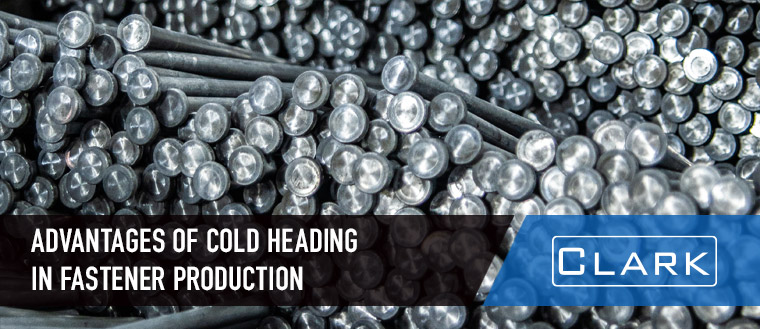Introduction
Cold heading refers to a highly advanced manufacturing tactical process. It involves cutting a wire from its coil and placing it to die. Next, a hammer extrudes or upset the material. The latter option breaks down the wire into something small, which is part of the die.
In the context of fastener production, cold-heading manufacturing rearranges working material and make it as straightforward as possible. It is more productive and practical than other production tactics that cast/ground into shape or need to cut the material.
Cold Headed Components
Cold heading is a solid manufacturing approach that rolls out cold-forming tactics in order to produce custom and standard fasteners efficiently and quickly. Products and components that are produced with this approach are famous as cold-headed.
The cold heading is a strategic and systematic process that requires using a cold heading machine. This includes a combination of specialized dies and hammers. A pre-cut wire or a slug gets inserted into a dedicated machine. And it is where the dies and hammers form into a pre-defined shape of the part.
You can guess it by its name – cold headed components don’t need heat to make cold-heading operations work. In fact, you can shape the component straight on cold metal.
Cold heading process revolves around these fundamental characteristics:
Almost No Waste of Material
The initial cut wire or slug pretty much has a similar volume to the end product. Additionally, you perform forming processes through a die – not cutting down the raw material based on the desired form and shape. These refined process qualities apply to all consumable raw materials to shape the process.
Versatility and Low Production Cost
It has become common to use cold heading to produce various products and parts. This also includes small fasteners like lugs, washers, shoulders, and screws.
Conversely, you can use cold heading to create large metal parts. And the best part about the cold heading process is that it doesn’t take nearly as much resources as the machining process. This makes the cold heading process an economically sound solution.

Cold Heading Technology and Fastener Manufacturing: New Age of Enhancing Production Efficiency and Product Quality
Compared to traditionally formed fasteners via old school manufacturing tactics – cold headed fasteners provide superior performance all around.
This inherent attribute comes out of significant rearrangements of raw material to better structure and make the cold heading process work its magic.
Sealing hardware produced via cold heading tactics showcases strong sealing capabilities.
There’s also a lot more attention to detail and material alteration to get the best results. It makes it easier to showcase end products tensile strength and durability.
Why Opt For Cold Headed Fasteners in 2023
- With the cold heading process – you can form solid fasteners that provide plenty of benefits. And it’s not just less material waste and high tensile strength.
- In the cold heading process, you can count on better production efficiency. In fact, cold heading makes it possible to speed up the production process and ensure a high volume of production at the same time.
- Another highlighting aspect of cold headed fasteners is that it promises broader and robust design versatility. And that’s because cold heading supports designs of all sizes, complexities, and shapes.
What Makes Cold Form Manufacturing So Beneficial
Cold forming manufacturers offer a lot of perks to their processes. Experts usually utilize this cold form manufacturing process for complex components and fasteners.
Large Production
Since the machinery works at such a high speed – it can create millions of parts a year. This is efficiency at scale and allows manufacturers to handle high volume and meet time-sensitive deadlines on time.
Speed and Efficiency
When it comes to a fast process – you can’t beat cold forming. This manufacturing process allows you to make 350 components a minute. On top of all, it’s a straightforward process that supports the production of non-complex components. For highly complex components, you can produce 200 components a minute. Remember that this is a sequential process where parts are produced in intervals.
Reduced Waste and Costs
Raw material yield is solid. It means with cold forming – you don’t have to worry about more machine scrap or shavings since it forms the component in almost net-state.
Durability and Strength
With cold forming – you can boost the metallurgical product properties. In fact, this ensures the parts’ integrity is intact and makes them more durable and stronger.
Scraping and Shaving
Now, the only shaving comes into play when you trim or pierce the shape of the component, which makes this manufacturing process incredibly eco-friendly.
Methodical Process
When it comes to the cold heading approach, know that it is a methodical process. It can support you to form specific diameters to a net shape or altogether to a different diameter.
Higher Integrity of Parts
This cuts out the need to access complex machining operations. You can also convert some parts from machining to a cold forming process. And this improves the integrity of the part and reduces overall cost.
Cold Heading in Fastener Production: Methods
There is more than one method that you can use for cold headed manufacturing. For starters, upsetting is the most common method associated with cold heading for fastener production.
The idea of using an upsetting method is to produce a fastener head. It doesn’t involve an amount limit of material that you can upset – and allows you to form a highly complex component where you can move more metal. And then there are backward extrusion and near net shape methods.
Backward extrusion involves an angular take since it doesn’t have a spot for metal to go anywhere. So, it flows in line with the outer punch perimeter and die backward. With a near-net shape, you form component using a cold heading machine to save as much cost as possible.










